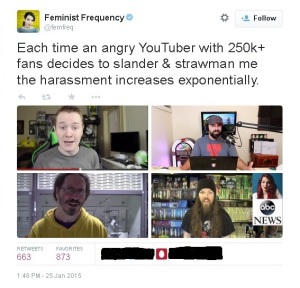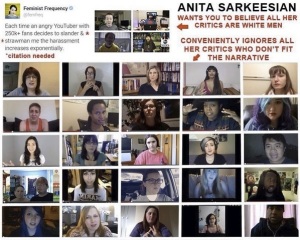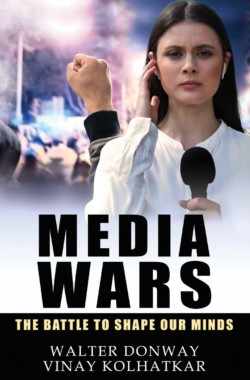Business Bashers Equate Criticism with Threats
Over the past several years, some commentators have become celebrities providing various critiques on specific industries. In the marketplace of ideas, it is natural that some other people would dispute these celebrities and air such disagreements on the World Wide Web. As humanity boasts a wide diversity in different personality types and communication styles, it comes as little surprise that such critiques vary in quality.
Some disputations of the celebrity’s claims are bellicose. A number of unhinged persons issue outright violent threats against the celebrity—a practice that should never be tolerated and which ought to be taken seriously by police, even if there is a small chance of the threat-issuer acting on his or her threats. By contrast, there are some persons who engage in quite civil discourse, respecting the celebrity as a person with legitimate feelings while still citing facts that contradict the celebrity’s claims. Between the two extremes are some mixed cases—persons who engage in some angry verbiage and hurl derogatory epithets, but nonetheless raise some valid points that concrete evidence supports.
Unfortunately, Ms. Hari has grown famous issuing increasingly bizarre proclamations about what in food is safe and what is not.
None of this diversity should be shocking, except a rather ominous trend has arisen in how such celebrities purport to address such dissent—rather than separate the arbitrary derogation and outright threats from the civil disputation, the celebrities merely present out-of-context examples of the more vitriolic responses they receive, and then imply that the vitriolic responses are representative of all deviation from their conclusions.
Rude About Food
This trend has been visible in the rise of Vani Hari, the health blogger known as Food Babe. Capitalizing on what began as legitimate concerns about toxic chemicals in the environment in the 1970s, Ms. Hari has exploited such fears and concerns about “food purity” in providing dieting advice on her blog. Unfortunately, Ms. Hari has grown famous issuing increasingly bizarre proclamations about what in food is safe and what is not.
She brazenly denies the scientific fact that what causes someone to be poisoned by any specific chemical is not exposure to the chemical per se, but receiving a dosage of exposure to that chemical that passes the threshold between safety and danger. She tells The Atlantic magazine, “There is just no acceptable level of any chemical to ingest, ever.” And, of course, she demonizes the use of genetically modified organisms (GMOs) in food production and, with it, the company most famously associated with agricultural GMOs—Monsanto. Her online writings imply that transgenics being a relatively new method of food production somehow renders food produced through transgenics to be dangerous. That elides the fact that the GMO food she criticizes does not differ in nutritional content from the non-GMO, organic equivalent.
She has also claimed that air in commercial jets suffers from hazardous levels of toxicity because the air is more than fifty percent nitrogen—ignoring the fact that, since the evolution of Homo sapiens, the air our species has breathed in was always more than fifty percent nitrogen. Upon scientists pointing out this inaccuracy to Ms. Hari, she hid the original version of the blog post advancing the assertion, but did not bother to admit to having erred on this topic.
Hari’s unscientific scaremongering has become a lucrative business. She has garnered headlines vilifying the products of companies like Subway as unsafe. She does endorse the products of some smaller companies, and earns a commission when someone purchases those products through her site. Other companies later take her on as a consultant.
Amidst vaunted scientists pointing out the manner in which Hari’s claims about food safety are misleading, Hari has lashed out, airing the arbitrary accusation that “detractors” who contradict her on Facebook are “paid 60 cents per post by BIG FOOD or BIG AG PR…”
More pertinent to this discussion, Ms. Hari has publicly proclaimed herself the victim of persecution. On her blog, she produced screen captures of misogynist remarks about her and comments from people telling her they wish she would die. She then announces, “I am personally being subjected to hate speech, harassment and cyber-bullying on a daily basis.” What is troubling is that when reproducing these disturbing insults and threats, Ms. Hari places them in the same boat as scientist Kevin Folta addressing the scientific inaccuracies of her claims.
Definitely the threats and sexism and racism are not excusable, but it does not follow that the scientific criticisms of her assertions fall into the category of hate speech. There is nothing inherently wrong with an online commentator pointing out instances of vitriolic responses he or she receives. But when this same commentator also receives thoughtful criticisms citing evidence to contradict his or her pontifications, it is dishonest for that commentator to speak as if all rejoinders—including the actual, in-context citations of evidence—ought to be classified as ad-hominem vitriol and threats.
A Damsel Distressed By Video-Game Consumers?
A similar tactic is exploited to an even greater degree by Anita Sarkeesian and Jonathan McIntosh, creators of the internet-based video series Feminist Frequency, co-written by both, hosted by Sarkeesian, and produced by McIntosh. Feminist Frequency is most well-known for its as-of-yet-incomplete miniseries “Tropes Vs. Women in Video Games,” which purports that video games, in general, depict women in a misogynist fashion and thereby reinforce misogynist attitudes in the people who play them. As a result of the fame that Feminist Frequency has gained on account of this series, Business Week magazine dubs Ms. Sarkeesian, in a fawning cover story, “the gaming industry’s greatest adversary.”
If you do a quick Google search of Ms. Sarkeesian, you will no doubt come across verbiage against her that is rude and needlessly shrill. There have been reported death threats issued against Ms. Sarkeesian. Definitely such threats should not be tolerated, and the particularly angry and insulting sentiments expressed against Ms. Sarkeesian are counterproductive at best. However, it is by the design of Ms. Sarkeesian and Mr. McIntosh, along with a fully complicit mainstream news media, that actual valid disputation of Feminist Frequency’s assertions has been lumped together with the insults and threats.
Mainstream news sources, such as ABC News’ Nightline convey (a) that public opposition to Ms. Sarkeesian’s message consists almost entirely of insults and death threats, and (b) that these insults and death threats come from the consumer group calling itself Gamergate. These impressions are inaccurate on multiple levels. Actually, while most members of Gamergate do voice their distaste for Ms. Sarkeesian’s misrepresentations about both them and their favorite video games, Gamergate is not about her.
Ms. Sarkeesian had been denouncing video games as misogynist for Feminist Frequency since 2013, whereas Gamergate began in late 2014. In that two-year span, critics were already uploading videos onto YouTube—videos of varying quality—to argue against Feminist Frequency’s allegations. But those videos were not about Gamergate. What started Gamergate was something else. As video games arose to become an industry worth 93 billion U.S. dollars worldwide, so too did arise “video-game news websites”— websites providing information to readers about the latest video game titles to hit the shelves, as well as reviews of such titles. In August of 2014, video-game enthusiasts learned that writers for these video-game news sites carried numerous undisclosed conflicts of interest—writing positive articles about roommates and even lovers and failing to disclose the existence of such ties. This scandal was dubbed Gamergate.
When the video-game enthusiasts—who were eventually called Gamergate themselves as a group—complained about these undisclosed conflicts of interest to the news websites, the news websites decided to spin the story. The news sites said that because one prominent person implicated in these conflicts of interest was a woman and feminist, that meant that all criticisms about these conflicts were motivated by misogyny and that the complaining video-game enthusiasts were merely attempting to punish the implicated person for being a woman and feminist. It was only then—weeks into Gamergate—when Ms. Sarkeesian and Mr. McIntosh entered the fray. They said that since Gamergate members were all misogynistic, that meant that Gamergate was all just a backlash against Feminist Frequency itself. Juju Chang’s Nightline segment on Gamergate uncritically accepted and disseminated that narrative—as did Business Week, the New York Times, the Washington Post, and The Colbert Report.
All You Bigots Are Alike…
On January 25, 2015, Anita Sarkeesian publicly tweeted, “Each time an angry YouTuber with 250k+ fans decides to slander & strawman me the harassment increases exponentially.” The tweet included a collage of four white men, each of whom has had at least one YouTube video criticizing her.
The next day, she added, “I’m not going to waste time responding to ad hominems, strawmen or willful misrepresentations of my arguments.” The implication was that the four white men pictured did nothing but what she mentioned—ad hominem and misrepresentation—and were therefore unworthy of rebuttal from her. The insinuations in these two tweets are troublesome for a number of reasons.
First is the way in which the four pictures are used to reinforce the narrative that only cisgendered (that is, non-transgendered), heterosexual white men take issue with her assertions. Feminist Frequency’s critics therefore made their own infographic to show the many women and members of racial minorities who have also publicly disputed Feminist Frequency’s claims.
 Second, there is misrepresentation of the four white men pictured in Ms. Sarkeesian’s first tweet. The tweet’s implication is that if harassment of Ms. Sarkeesian follows the uploading of a critical video from any one of these men, then it implies that the man is complicit in said harassment. Of course harassment is wrong, and Ms. Sarkeesian provides no evidence that any of the men condone harassment. And, were it the case that Person A should be condemned for publicly criticizing Public Figure B simply because that criticism might motivate Person C to harass Public Figure B, then it would mean magician James Randi should be blamed if, after hearing Randi’s public criticisms of celebrity psychic Uri Geller, a misguided fan of Randi’s harassed Geller.
Second, there is misrepresentation of the four white men pictured in Ms. Sarkeesian’s first tweet. The tweet’s implication is that if harassment of Ms. Sarkeesian follows the uploading of a critical video from any one of these men, then it implies that the man is complicit in said harassment. Of course harassment is wrong, and Ms. Sarkeesian provides no evidence that any of the men condone harassment. And, were it the case that Person A should be condemned for publicly criticizing Public Figure B simply because that criticism might motivate Person C to harass Public Figure B, then it would mean magician James Randi should be blamed if, after hearing Randi’s public criticisms of celebrity psychic Uri Geller, a misguided fan of Randi’s harassed Geller.
At least two of the men pictured in Sarkeesian’s tweet have engaged in some unfortunate name-calling, proclaiming Ms. Sarkeesian a “scam artist.” It does not follow from that, though, that the four men simply engaged in lies or insults. Among the four of them, some valid issues of contention have been raised—issues that should be considered by someone who wants to determine whether Ms. Sarkeesian’s accusations about video games being misogynist are correct.
Feminist Frequency: Frequently Distorting Context
One of the men pictured, Phil Mason, a.k.a., “thunderf00t,” speaks about Ms. Sarkeesian’s depiction of the video game Hitman: Absolution. This is a “dark,” cynical game in which the player plays as a hired assassin. Each stage involves the player navigating an urban environment where the hit man must stealthily assassinate the “mark.” That sounds quite villainous, but the assassin’s targets are gangsters more evil than the parties who contracted with the hit man. Characters that are controlled by the computer and not by the player are called NPCs—non-player characters. Besides the Mafioso “mark” for each stage, other NPCs include bystanders. The player can have the hit man execute bystanders as well, but the video game severely penalizes the player for doing so—after all, slaying bystanders increases the risk of detection by authorities. Killing bystanders causes the player to lose points and possibly the game itself. On one level, the hit man is supposed to go through a strip club, sneak past several strippers conversing with one another, and then eighty-six the gangster target.
A social conservative can easily find fault with Hitman: Absolution’s nihilistic portrayal of humanity in general, but Feminist Frequency takes a different tack. Feminist Frequency depicts footage of the player character killing the strippers in the joint, and then presents the footage as if killing the strippers is the object of the game. Thunderf00t—whom Sarkeesian accuses of “slander”—is correct in pointing out how misleading the out-of-context footage is. Yet, amidst that point being raised, Ms. Sarkeesian did nothing more than brush it off: “Those accusing me of misrepresenting Hitman: Absolution don’t understand my argument. I humbly suggest they watch my video again, carefully.” As of this writing, that is all Ms. Sarkeesian has said about it. That is no clarification—it is an arbitrary dismissal. A social conservative wanting to moralize about the game at least could have cited the cynical depiction of men as killers. Instead, Feminist Frequency shoehorns critique of its game into its games-are-misogynist narrative by falsely depicting the game as being more negative in its depiction of women than of men.
Much more optimistic, lighthearted, and kid-friendly games are also subjected to misrepresentation by Feminist Frequency. Quite glaring is Feminist Frequency’s revisionist telling of the history behind the game StarFox Adventures. StarFox is a franchise of Nintendo games going back to 1993. They take place in outer space and involve dogfights among spaceships, à la the climax of Star War, Episode IV: A New Hope, but the characters are anthropomorphized animals. Just as Donald Duck is an anthropomorphized duck, StarFox’s protagonist—Fox McCloud—is a male fox who talks and dresses like a human man, and who pilots a spaceship.
Ms. Sarkeesian’s inaccurate telling of the history of Star Fox Adventures is as follows. In 1999, Nintendo considered making a game called Dinosaur Planet. Sarkeesian quickly mentions the game was to have two playable protagonists, and then focuses on one being a smart, independent, and decidedly female anthropomorphized fox named Krystal. No more mention is made of the other playable protagonist as Sarkeesian expounds upon how the game was to be about Krystal traveling around and encountering dinosaurs. This would have made Krystal a positive role model to little girls. But then, Ms. Sarkeesian adds darkly, male chauvinism intervened. Nintendo bigwig Shigeru Miyamoto—creator of Donkey Kong, Super Mario Bros., and Legend of Zelda—thought a game with a female protagonist would not sell well. Therefore, he ascertained Dinosaur Planet should be an entry in the StarFox franchise. Dinosaur Planet was renamed StarFox Adventures, and the protagonist would thus be the decidedly masculine Fox McCloud. Krystal was subsequently relegated to the role of the male hero’s sidekick and love interest. Thus, concludes Feminist Frequency, male patriarchy snuffed out female empowerment once again.
But Ms. Sarkeesian’s telling of the story is false. Throughout the entire sequence of Dinosaur Planet’s development, Krystal always shared the spotlight with another protagonist. From inception, the premise was that there were two main characters—a male fox, named Sabre, and a female one, Krystal. Miyamoto figured that the male fox hero Sabre already resembled the already-bankable Fox McCloud, and therefore it was logical to exchange the vaguely defined Sabre for the more-familiar McCloud. Sarkeesian’s morality tale about Japanese businessmen suppressing what had been first conceived as a female-empowerment narrative is phony. As of this writing, Ms. Sarkeesian and Mr. McIntosh have not acknowledged this.
Feminist Frequency does not lack for celebrity endorsement. Joss Whedon, the director of Marvel’s The Avengers and creator of Buffy the Vampire Slayer and Firefly, proclaims that all of Ms. Sarkeesian’s accusations about games are accurate. Whedon wants Feminist Frequency’s critics to shut their mouths, because Sarkeesian engages in nothing but pure “truth-telling. Deal[with it].”
For someone to judge Feminist Frequency’s depictions of such games as accurate, though, one largely has to be unfamiliar with them. When Feminist Frequency denounces a fiction franchise that is much more well-known, the deconstructionist method whereby the fiction’s theme is grossly misinterpreted becomes more obvious.
Consider how, on its official Facebook page, Feminist Frequency issues a moral condemnation of a much-beloved superhero: “Batman is inherently a story about a capitalist that seeks revenge for the death of his parents, he’s a vigilante, outside the law, that basically kills and beats up the mentally disabled.” Later in the Facebook thread in which that comment appears, Feminist Frequency retracts the remark about Batman killing people—in the Christopher Nolan movies, Batman has a rule that he must not kill. Nevertheless, Feminist Frequency maintains that Batman still “does beat up” the mentally disabled. The implication is that the villains in Batman’s rogue’s gallery are poor, innocent victims of mental illness—an oppressed class in society—and then the big billionaire has impunity in bullying these people over nothing.
 Feminist Frequency’s characterization of Batman’s villains as “mentally disabled” is a prevarication. Mental illness exists along a continuum—it comes in varying degrees. On one end of the spectrum, a person can be completely in control of his or her own actions. On the other end, someone can be completely out of control—comprehending absolutely nothing around him or her.
Feminist Frequency’s characterization of Batman’s villains as “mentally disabled” is a prevarication. Mental illness exists along a continuum—it comes in varying degrees. On one end of the spectrum, a person can be completely in control of his or her own actions. On the other end, someone can be completely out of control—comprehending absolutely nothing around him or her.
There are different mental illnesses that come in varying shades of severity. Unless such a person is at the extreme level of lacking control, even someone suffering from mental illness retains some degree of volition. And, to the extent that that person retains volition, he or she remains a moral agent who can properly be deemed morally responsible for his or her own actions.
The Riddler, for example, might exhibit symptoms of obsessive-compulsive disorder and clinical narcissism, but if he were completely lacking in mental stability, he would not be able to plan anything, let alone his elaborate schemes. Psychopaths are mentally ill inasmuch as they experience a diminished capacity for affective empathy, but they maintain sufficient cognitive volition to understand, at least superficially, the harmful consequences of their own actions. Therefore, the mere presence of mental illness does not exculpate someone from moral culpability, and Batman is not being a bully toward the Riddler and the Joker when he exercises necessary force upon them in order to protect peaceful citizens from the carnage that the Riddler and the Joker would otherwise initiate.
If you see that Feminist Frequency’s denunciation of Batman is silly at best, it is because you have some familiarity with the Batman franchise. By contrast, if you are unfamiliar with Hitman: Absolution and StarFox Adventures, and you take Feminist Frequency’s claims at face value, it is very easy to conclude, as Joss Whedon does, that Feminist Frequency is utterly meticulous in exposing the mistreatment of women in these games.
And hagiographic profiles in the New York Times and Washington Post, and on ABC News’s Nightline, would have respective readers and viewers under the impression that any philosophic dissension from Ms. Sarkeesian is mistreatment of the same sort—male antagonism ranging from male-centered condescension (mansplaining) to the violent desire to rape and murder.
One might retort to all this, “So what if Feminist Frequency grossly misinterprets video games? Criticizing Batman is no big deal, because Batman is fictional. Likewise, video games are just toys. Who cares?” But as we have seen, Feminist Frequency’s propaganda has had serious consequences—it got the New York Times, Washington Post, Business Week, and ABC News to assist in propagating Jonathan McIntosh’s Moral Panic, thereby stigmatizing thousands of peaceful players of video games as violent. The nation’s most respected newspapers successfully stigmatizing innocent people is a big deal.
Even Gentle Critics Are Conflated With the Bigoted and the Violent
The female YouTube vlogger “KiteTales” has a video rebutting Feminist Frequency. This KiteTales video is consistently polite—even gentle—as it brings up considerations that refute Feminist Frequency’s assertions that Super Mario Bros. and Legend of Zelda are misogynist in their depictions of their princess characters. Still, we have yet to see Feminist Frequency engage with the counterpoints from KiteTales. Sarkeesian is too busy sending out tweets about how she is too good to address unfair rhetoric from aggressive white men—as if that is the bulk of the ideological opposition she and Mr. McIntosh face.
Just as Food Babe has won consulting fees amidst her activism, Feminist Frequency seems to have cashed in as well. Feminist Frequency has reportedly accrued 400,000 U.S. dollars in 2014 alone, and, despite Mr. McIntosh very publicly and disturbingly denigrating U.S. soldiers and Charlie Hebdo’s slain cartoonists, such a prestigious corporation as Intel announced on January 6 of this year that it intends to partner with Feminist Frequency to advance a politically correct message. Evidently, if you spend enough time and effort attacking big business as evil, big businesses will eventually pay you off. How convenient.
Of course, some people who are rational in their criticisms in some areas of life are irrational in other areas. Online, I have interacted with many scientifically-minded people who have criticized the misleading activism of “Food Babe” Vani Hari. They are fully aware of how unfair it is when Hari obfuscates their own legitimate concerns about her scientific inaccuracies with the bigoted insults and threats she receives. Yet, bewilderingly, some of these very same scientifically-minded people—proclaiming themselves to be intersectional feminists—have uncritically accepted, at face value, the false narrative of Anita Sarkeesian speaking Truth to Power, this Truth being rejected exclusively by people who are bigoted, violent, or both.
I understand that being a well-known controversial figure is not easy. If, every day, a hundred people tweet the exact same counterarguments to you, that can become quite aggravating. At that juncture, even a rather minor point of contention—that would not cause offense if taken in isolation, not preceded by hours’ worth of angry messages—can feel hurtful.
Still, amidst this stress, even such well-known controversial figures as Vani “Food Babe” Hari, Anita Sarkeesian, and Jonathan McIntosh should bear a responsibility to be honest with the public they address. I do not think Ms. Sarkeesian has any sort of moral duty to address any or all criticism of her. But, by that same token, she should not be surprised if, upon refusing to address actual evidence-supported grievances, as well as such calmly laid-out counterpoints as KiteTales’, the very people from whom Sarkeesian demands some moral transformation, end up remaining doubtful about the veracity of what she says. It is not sufficient to do as she demands of her audience—“Listen and Believe”; we need evidence that is presented in its proper context and which can withstand the sort of rational scrutiny that KiteTales provides.
Insofar as such critics of industry as Vani Hari, Anita Sarkeesian, and Jonathan McIntosh receive bigoted insults and violent threats, they deserve our compassion. No one should be on the receiving end of that. And, by that same token, such hostile treatment of Food Babe and Feminist Frequency nevertheless cannot excuse the manner in which these respective parties have smeared honest, civil, peaceful critics by publicly conflating them with the issuers of bigoted insults and threats.
« Fifty Shades of Grey Is a Virgin Mary Raising Children is an Act of Philosophy »










